Part IV: Data Manipulation
Subsetting and filtering data
Subsetting and filtering data involve selecting specific elements, rows, or columns from a dataset based on certain conditions or criteria. In R, subsetting can be achieved using square brackets [], the subset() function, or dplyr package functions like filter() for rows and select() for columns. Filtering refers more specifically to choosing rows that meet certain conditions, such as values within a range or matching specific characteristics.
# Creating a sample data frame
data <- data.frame(
id = 1:5,
name = c("Alice", "Bob", "Charlie", "David", "Eva"),
age = c(25, 30, 22, 28, 24)
)
# Subsetting by a specific column
ages <- data$age
print(ages)
#> [1] 25 30 22 28 24
# Filtering data based on a condition
young_adults <- subset(data, age < 30)
print(young_adults)
#> id name age
#> 1 1 Alice 25
#> 3 3 Charlie 22
#> 4 4 David 28
#> 5 5 Eva 24Using the dplyr package
The %>% symbol in R is known as the pipe operator, and it’s used to pass the result of one expression as the first argument to the next expression
- Filtering data using dplyr for individuals younger than 30
library(dplyr)
#>
#> Attaching package: 'dplyr'
#> The following objects are masked from 'package:stats':
#>
#> filter, lag
#> The following objects are masked from 'package:base':
#>
#> intersect, setdiff, setequal, union
young_adults <- data %>% filter(age < 30)
print(young_adults)
#> id name age
#> 1 1 Alice 25
#> 2 3 Charlie 22
#> 3 4 David 28
#> 4 5 Eva 24- Subsetting columns using dplyr
Adding, removing, and renaming columns
- Adding a new column ‘salary’
data$salary <- c(55000, 50000, 60000, 52000, 58000)
print(data)
#> id name age salary
#> 1 1 Alice 25 55000
#> 2 2 Bob 30 50000
#> 3 3 Charlie 22 60000
#> 4 4 David 28 52000
#> 5 5 Eva 24 58000- Removing the ‘salary’ column
data$salary <- NULL
print(data)
#> id name age
#> 1 1 Alice 25
#> 2 2 Bob 30
#> 3 3 Charlie 22
#> 4 4 David 28
#> 5 5 Eva 24- Renaming the ‘name’ column to ‘first_name’
Using the dplyr package
- Adding a new column ‘salary’ using mutate
data <- data %>%
mutate(salary = c(55000, 50000, 60000, 52000, 58000))
print(data)
#> id name age salary
#> 1 1 Alice 25 55000
#> 2 2 Bob 30 50000
#> 3 3 Charlie 22 60000
#> 4 4 David 28 52000
#> 5 5 Eva 24 58000- Removing the ‘salary’ column using select
data <- data %>%
select(-salary)
print(data)
#> id name age
#> 1 1 Alice 25
#> 2 2 Bob 30
#> 3 3 Charlie 22
#> 4 4 David 28
#> 5 5 Eva 24- Renaming the ‘name’ column to ‘first_name’ using rename
Why use dyplr
One might think that using pipe operator (%>%) from the magrittr package, prominently used in dplyr and the wider tidyverse is unnecessarily more complex. While it may seem more complex at first, especially to those accustomed to base R functions and syntax, it offers several benefits that can greatly enhance the readability, efficiency, and overall workflow of data analysis. Some reasons to use it are:
- Improved Readability and Clarity
- Easier Debugging and Modification
- Enhanced Workflow
- Consistency and Community Adoption
- Efficiency in Writing Code
An example of the benefits is seen in more complex operations making them more readable
Let’s just add salary column again.
data$salary <- c(55000, 50000, 60000, 52000, 58000)
subsetting_data <- within(data[data$age < 30, -which(names(data) == "salary")], names(name) <- "first_name")
subsetting_data
#> id name age
#> 1 1 Alice 25
#> 3 3 Charlie 22
#> 4 4 David 28
#> 5 5 Eva 24Now, doing it using dplyr
data <- data %>%
mutate(salary = c(55000, 50000, 60000, 52000, 58000))
data <- data %>%
filter(age < 30) %>%
select(-salary) %>%
rename(first_name = name)
data
#> id first_name age
#> 1 1 Alice 25
#> 2 3 Charlie 22
#> 3 4 David 28
#> 4 5 Eva 24Without using the pipe operator , it looks not so clear.
data <- data.frame(
id = 1:5,
name = c("Alice", "Bob", "Charlie", "David", "Eva"),
age = c(25, 30, 22, 28, 24)
)
data <- data %>%
mutate(salary = c(55000, 50000, 60000, 52000, 58000))
subsetting_data <- rename(select(
filter(data, age < 30), -salary),
first_name = name)
subsetting_data
#> id first_name age
#> 1 1 Alice 25
#> 2 3 Charlie 22
#> 3 4 David 28
#> 4 5 Eva 24Basic data summary and exploration
A very brief summary and data exploration is given below.
- Summary statistics of the data frame
summary(data)
#> id name age
#> Min. :1 Length:5 Min. :22.0
#> 1st Qu.:2 Class :character 1st Qu.:24.0
#> Median :3 Mode :character Median :25.0
#> Mean :3 Mean :25.8
#> 3rd Qu.:4 3rd Qu.:28.0
#> Max. :5 Max. :30.0
#> salary
#> Min. :50000
#> 1st Qu.:52000
#> Median :55000
#> Mean :55000
#> 3rd Qu.:58000
#> Max. :60000- Structure of the data frame
str(data)
#> 'data.frame': 5 obs. of 4 variables:
#> $ id : int 1 2 3 4 5
#> $ name : chr "Alice" "Bob" "Charlie" "David" ...
#> $ age : num 25 30 22 28 24
#> $ salary: num 55000 50000 60000 52000 58000- Average age of the individuals in the data frame
- Count of unique names in the data frame
Exploratory data analysis
Exploratory Data Analysis (EDA) is a critical initial step in the data analysis process, where the main characteristics of a dataset are examined to understand its structure, uncover patterns, identify anomalies, and test hypotheses. The goal is to use statistical summaries and visualizations to get a sense of the data, which guides further analysis and modeling decisions. EDA is not about making formal predictions or testing hypotheses but rather about asking questions and seeking insights in a more open-ended, exploratory manner.
Key Components of EDA include:
Understanding the Distribution of various variables in the dataset. This involves looking at measures like mean, median, mode, range, variance, and standard deviation, and using visual tools like histograms, box plots, and density plots to understand how the data is spread out.
Identifying Patterns and Relationships between variables using scatter plots, pair plots, and correlation matrices. This helps in understanding how variables are related to each other and can guide more complex analyses like regression or classification.
Detecting Anomalies such as outliers or unexpected values which might indicate errors in data collection or provide insights into unusual occurrences in the data.
Cleaning Data by addressing missing values, duplicate data, and making decisions about how to correct inconsistencies based on the insights gained.
Transforming Variables when necessary to make the data more suitable for analysis. This could involve normalizing the data, creating categorical variables from continuous ones, or engineering new variables from existing ones.
Tools and Techniques
Statistical Summary Functions in R (summary(), mean(), sd(), etc.) provide quick insights into the basic properties of the data.
Visualization Libraries like ggplot2 in R for creating a wide range of plots and charts that reveal the underlying patterns and structures in the data.
Importance of EDA
Data Understanding: It ensures that the analyst has a thorough understanding of the dataset’s features, values, and relationships between variables.
Guiding Hypotheses: Insights gained during EDA can help form hypotheses for statistical testing and predictive modeling.
Modeling Strategy: Identifying the key variables and their relationships helps in choosing appropriate models and techniques for further analysis.
In summary, EDA is an essential practice in data science for making sense of data, discovering patterns, identifying potential problems, and informing subsequent steps in the analytical process. It blends statistical techniques with visual explorations to create a foundation for any data-driven task.
Now we will explore a dataset from the library AER , and a numeric variable first
Numeric Variable
#install.packages("AER")
library(AER)
#> Loading required package: car
#> Loading required package: carData
#>
#> Attaching package: 'car'
#> The following object is masked from 'package:dplyr':
#>
#> recode
#> Loading required package: lmtest
#> Loading required package: zoo
#>
#> Attaching package: 'zoo'
#> The following objects are masked from 'package:base':
#>
#> as.Date, as.Date.numeric
#> Loading required package: sandwich
#> Loading required package: survival
data("CPS1985")
str(CPS1985)
#> 'data.frame': 534 obs. of 11 variables:
#> $ wage : num 5.1 4.95 6.67 4 7.5 ...
#> $ education : num 8 9 12 12 12 13 10 12 16 12 ...
#> $ experience: num 21 42 1 4 17 9 27 9 11 9 ...
#> $ age : num 35 57 19 22 35 28 43 27 33 27 ...
#> $ ethnicity : Factor w/ 3 levels "cauc","hispanic",..: 2 1 1 1 1 1 1 1 1 1 ...
#> $ region : Factor w/ 2 levels "south","other": 2 2 2 2 2 2 1 2 2 2 ...
#> $ gender : Factor w/ 2 levels "male","female": 2 2 1 1 1 1 1 1 1 1 ...
#> $ occupation: Factor w/ 6 levels "worker","technical",..: 1 1 1 1 1 1 1 1 1 1 ...
#> $ sector : Factor w/ 3 levels "manufacturing",..: 1 1 1 3 3 3 3 3 1 3 ...
#> $ union : Factor w/ 2 levels "no","yes": 1 1 1 1 1 2 1 1 1 1 ...
#> $ married : Factor w/ 2 levels "no","yes": 2 2 1 1 2 1 1 1 2 1 ...
head(CPS1985)
#> wage education experience age ethnicity region gender
#> 1 5.10 8 21 35 hispanic other female
#> 1100 4.95 9 42 57 cauc other female
#> 2 6.67 12 1 19 cauc other male
#> 3 4.00 12 4 22 cauc other male
#> 4 7.50 12 17 35 cauc other male
#> 5 13.07 13 9 28 cauc other male
#> occupation sector union married
#> 1 worker manufacturing no yes
#> 1100 worker manufacturing no yes
#> 2 worker manufacturing no no
#> 3 worker other no no
#> 4 worker other no yes
#> 5 worker other yes noObtain the summary statistics of the data frame, check whether it is numeric, get the mean , and variance.
summary(CPS1985$wage)
#> Min. 1st Qu. Median Mean 3rd Qu. Max.
#> 1.000 5.250 7.780 9.024 11.250 44.500
is.numeric(CPS1985$wage)
#> [1] TRUE
mean(CPS1985$wage)
#> [1] 9.024064
var(CPS1985$wage)
#> [1] 26.41032Now, visualize the wage distribution
hist(log(CPS1985$wage), freq = FALSE, nclass = 20, col = "light blue")
lines(density(log(CPS1985$wage)), col = "red")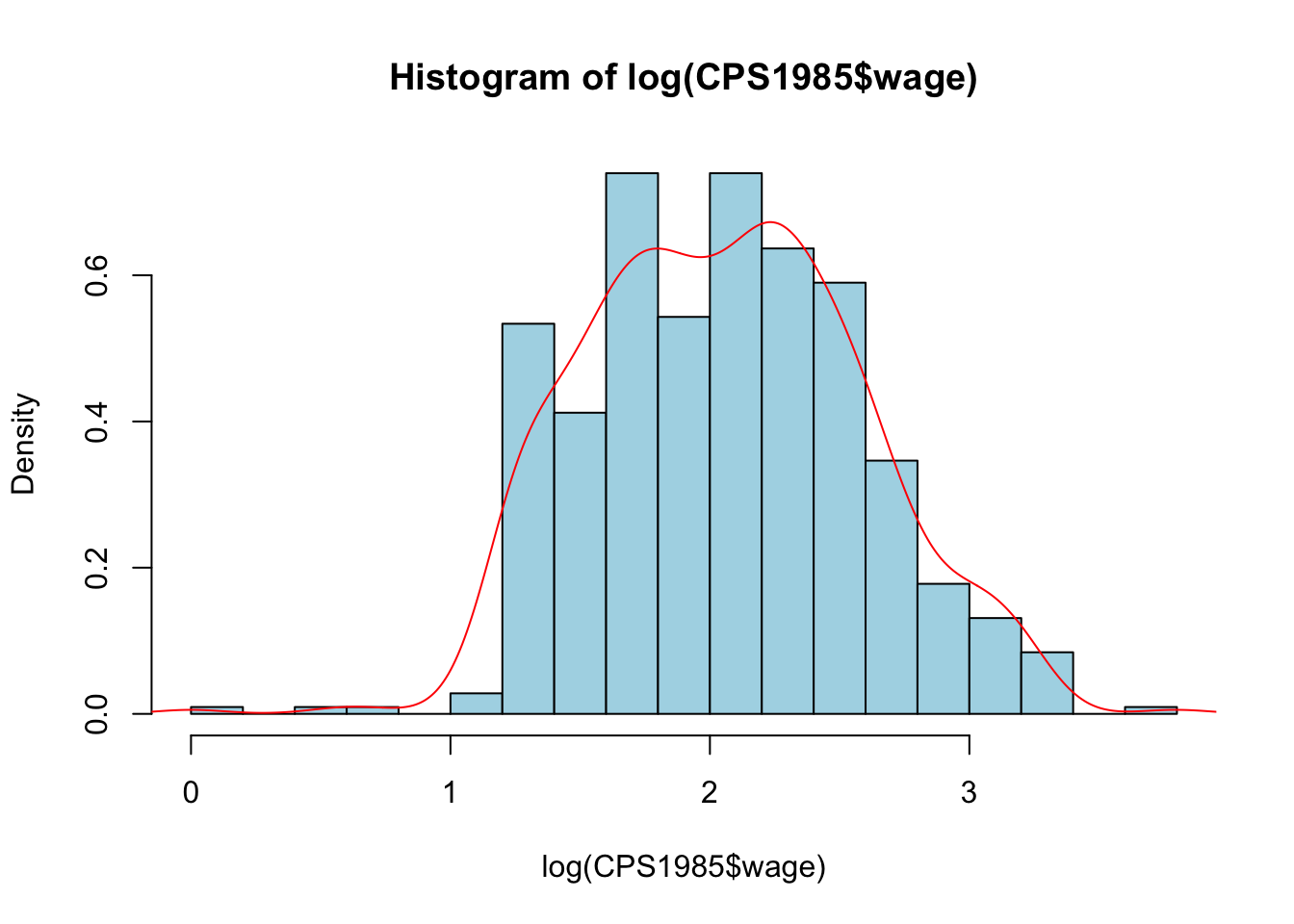
A factor variable
You now explore the occupation variable
summary(CPS1985$occupation)
#> worker technical services office sales
#> 156 105 83 97 38
#> management
#> 55change the names of some of the levels
levels(CPS1985$occupation)[c(2, 6)] <- c("techn", "mgmt")
summary(CPS1985$occupation)
#> worker techn services office sales mgmt
#> 156 105 83 97 38 55visualize the distribution
tab <- table(CPS1985$occupation)
prop.table(tab)
#>
#> worker techn services office sales
#> 0.29213483 0.19662921 0.15543071 0.18164794 0.07116105
#> mgmt
#> 0.10299625
barplot(tab)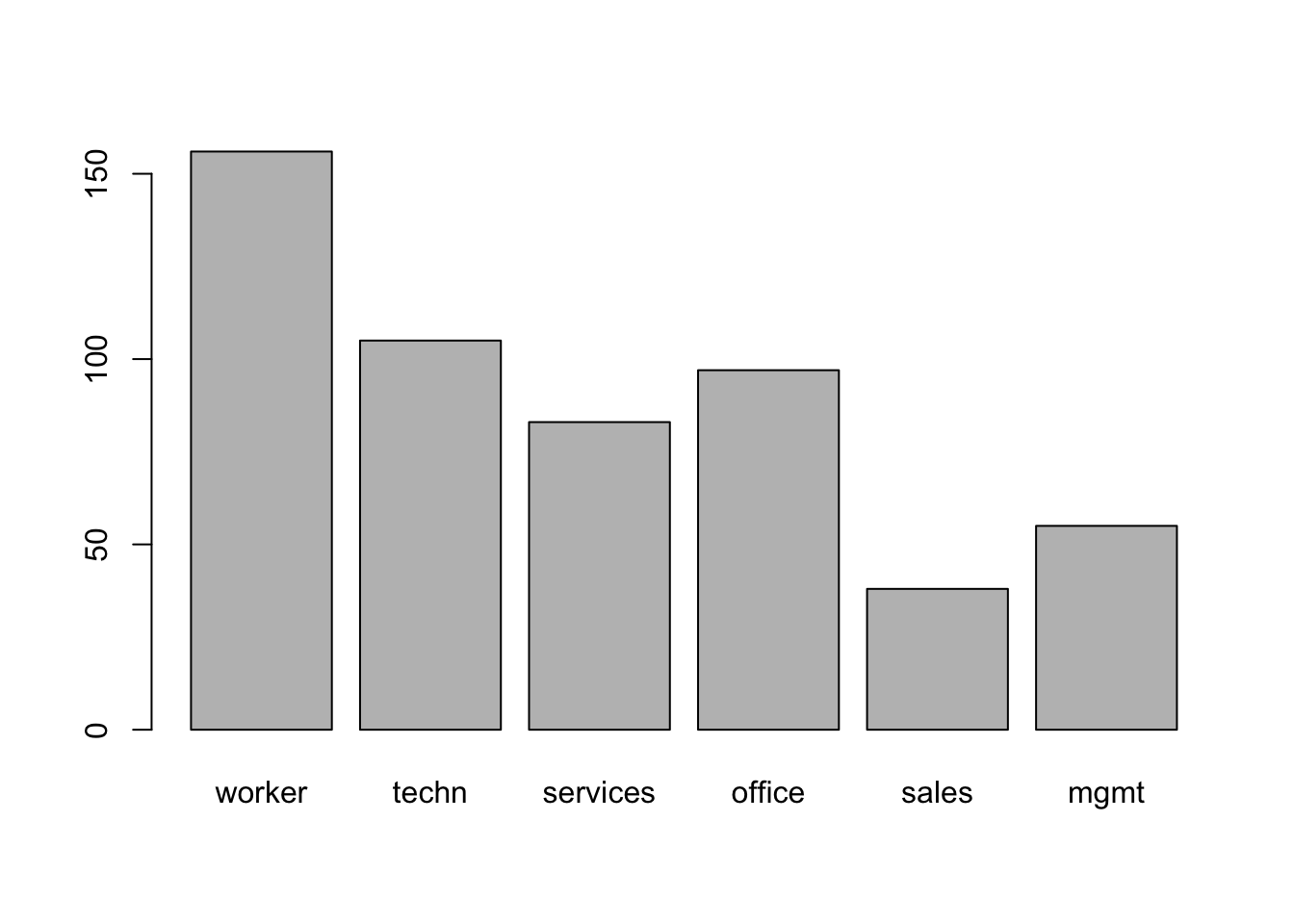
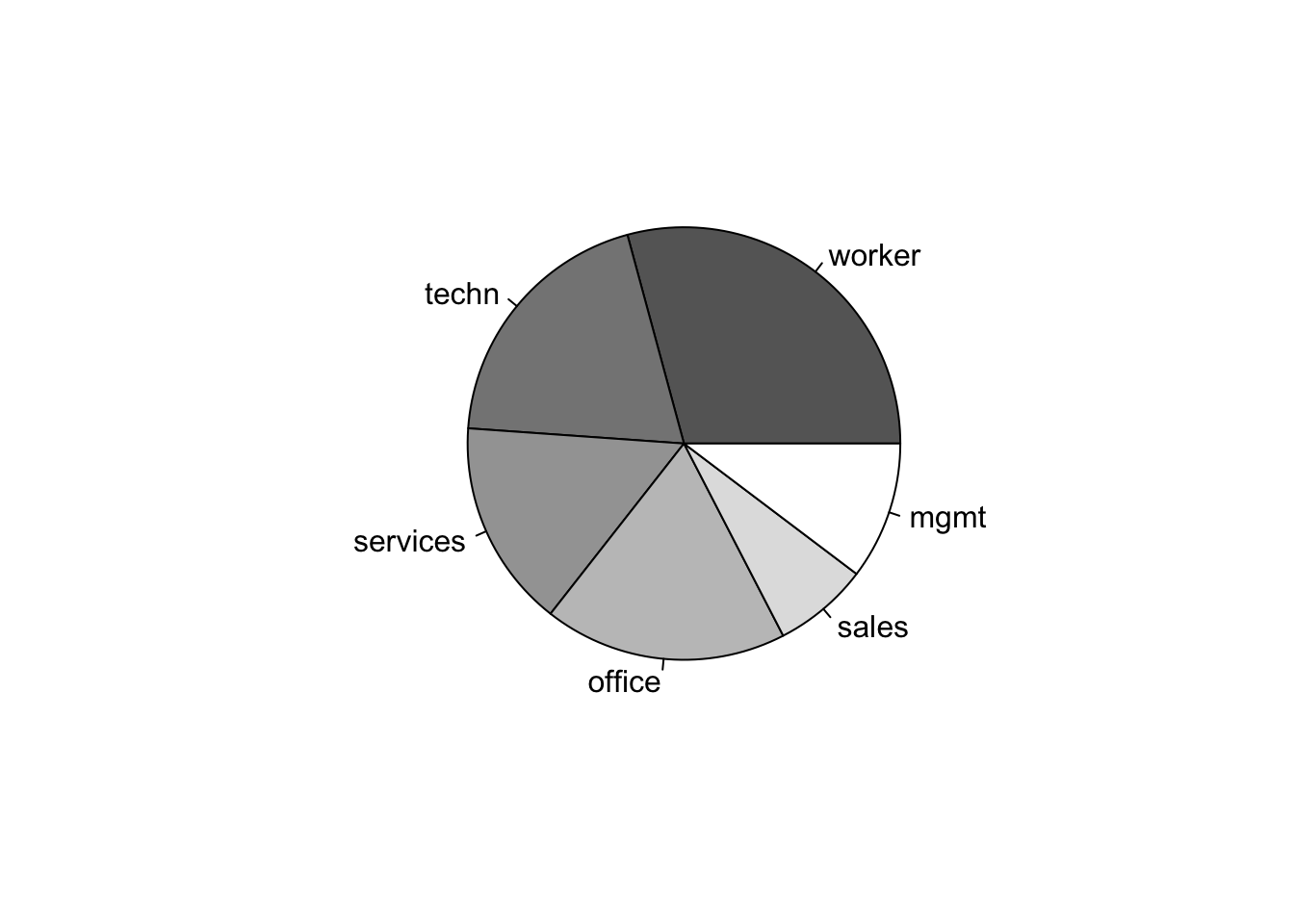
Two factor variables
You now explore the factor variables gender and occupation.
Use prop.table()
The prop.table() function in R is used to compute the proportion of table elements over the margin specified (if any). When applied to a contingency table created by the table() function, it transforms the table’s counts into proportions, making it easier to analyze the relative distribution of frequencies across different categories.
attach(CPS1985) # attach the data set to avoid use the operator $
table(gender, occupation) # no name_df$name_var necessary
#> occupation
#> gender worker techn services office sales mgmt
#> male 126 53 34 21 21 34
#> female 30 52 49 76 17 21
prop.table(table(gender, occupation))
#> occupation
#> gender worker techn services office
#> male 0.23595506 0.09925094 0.06367041 0.03932584
#> female 0.05617978 0.09737828 0.09176030 0.14232210
#> occupation
#> gender sales mgmt
#> male 0.03932584 0.06367041
#> female 0.03183521 0.03932584Now try prop.table(table(gender, occupation), 2)
prop.table(table(gender, occupation), 2) # 1 for row , 2 for columns
#> occupation
#> gender worker techn services office sales
#> male 0.8076923 0.5047619 0.4096386 0.2164948 0.5526316
#> female 0.1923077 0.4952381 0.5903614 0.7835052 0.4473684
#> occupation
#> gender mgmt
#> male 0.6181818
#> female 0.3818182You now explore the factor variables gender and occupation.
Do a mosaic plot
A mosaic plot, also known as a Marimekko diagram or a mosaic chart, is a graphical representation of data that allows for the visualization of the proportions or frequencies of categorical variables in a dataset. It’s a type of plot that provides a visual summary of the contingency table associated with two or more categorical variables. Each rectangle (tile) in the mosaic plot represents a combination of category levels from the variables, with the area of the rectangle proportional to the frequency or proportion of observations in that category combination.
plot(gender ~ occupation, data = CPS1985)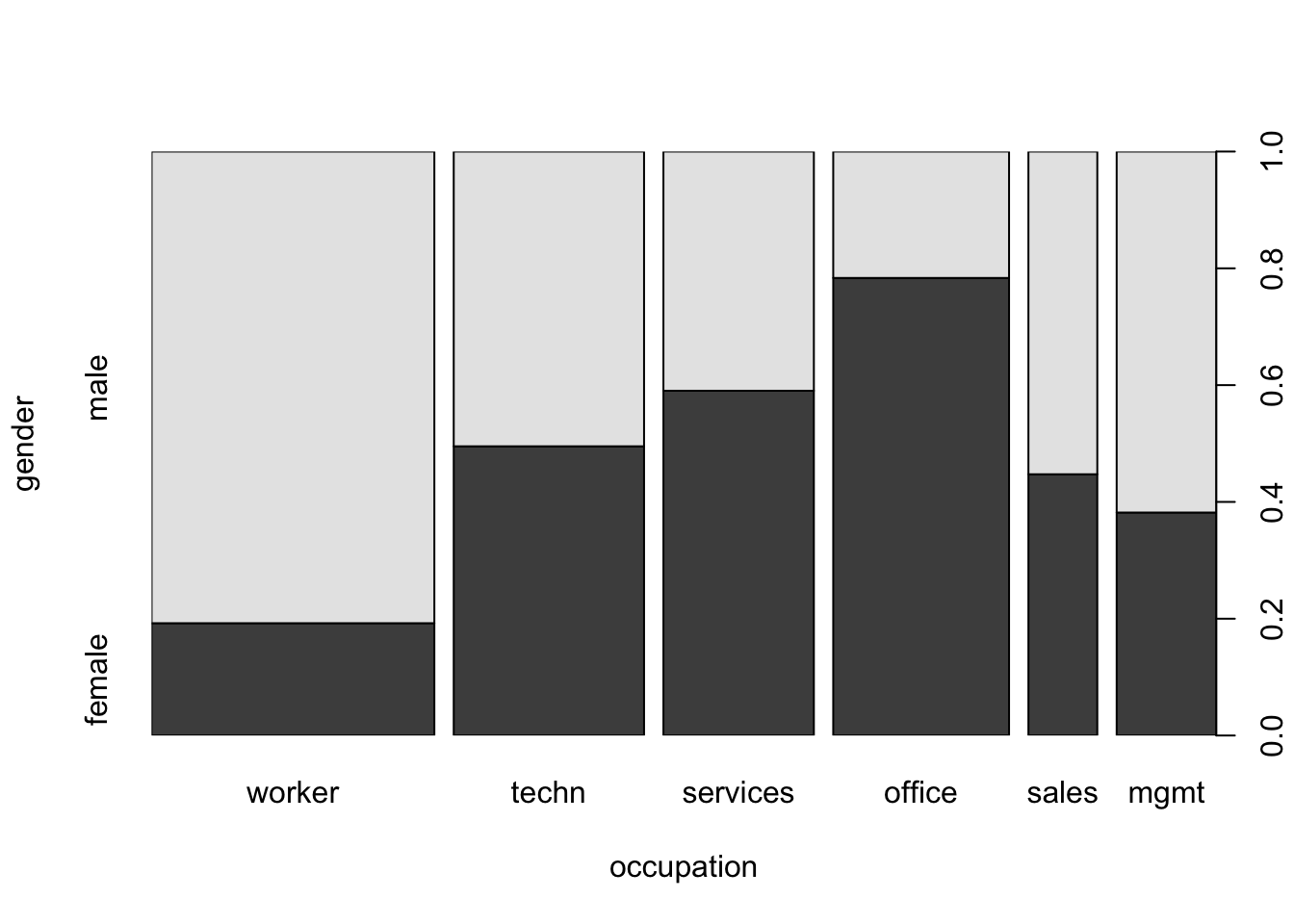
Now explore the factor gender and the numeric variable wage.
The tapply() function in R is used to apply a function to subsets of a vector, where subsets are defined by some other vector, usually a factor. The basic syntax of tapply() is:
- X is the object to be split and operated on.
- INDEX is the factor or list of factors according to which X is split.
- FUN is the function to be applied to each subset of X.
- … are optional arguments to FUN.
- simplify, when TRUE, tries to simplify the result to a vector, matrix, or higher-dimensional array; when FALSE, the result is a list.
tapply(wage, gender, mean)
#> male female
#> 9.994913 7.878857A factor and a numeric variable
Explore a factor variable and a numeric variable.
Visualize the distribution of wage per gender
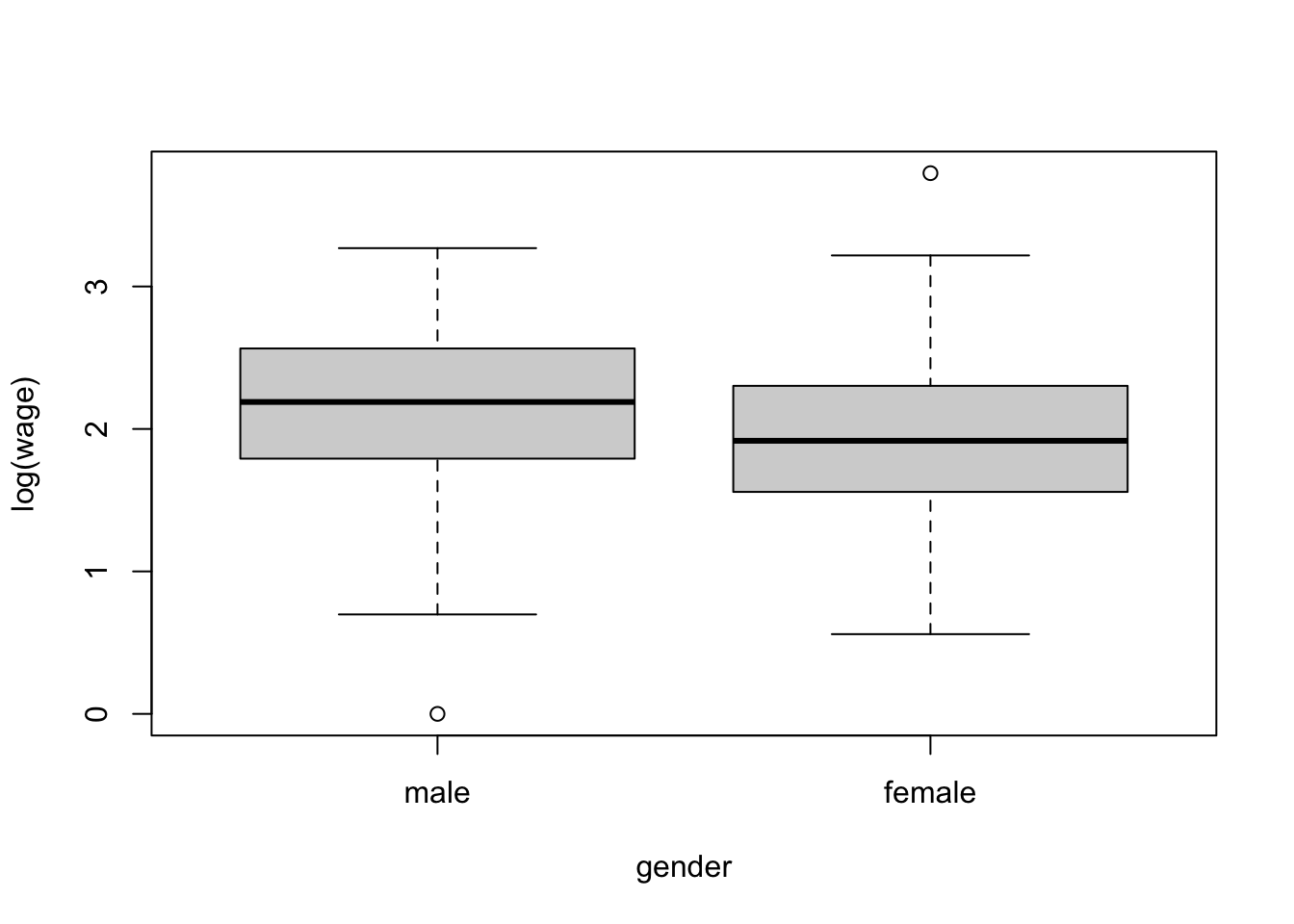
Now try with
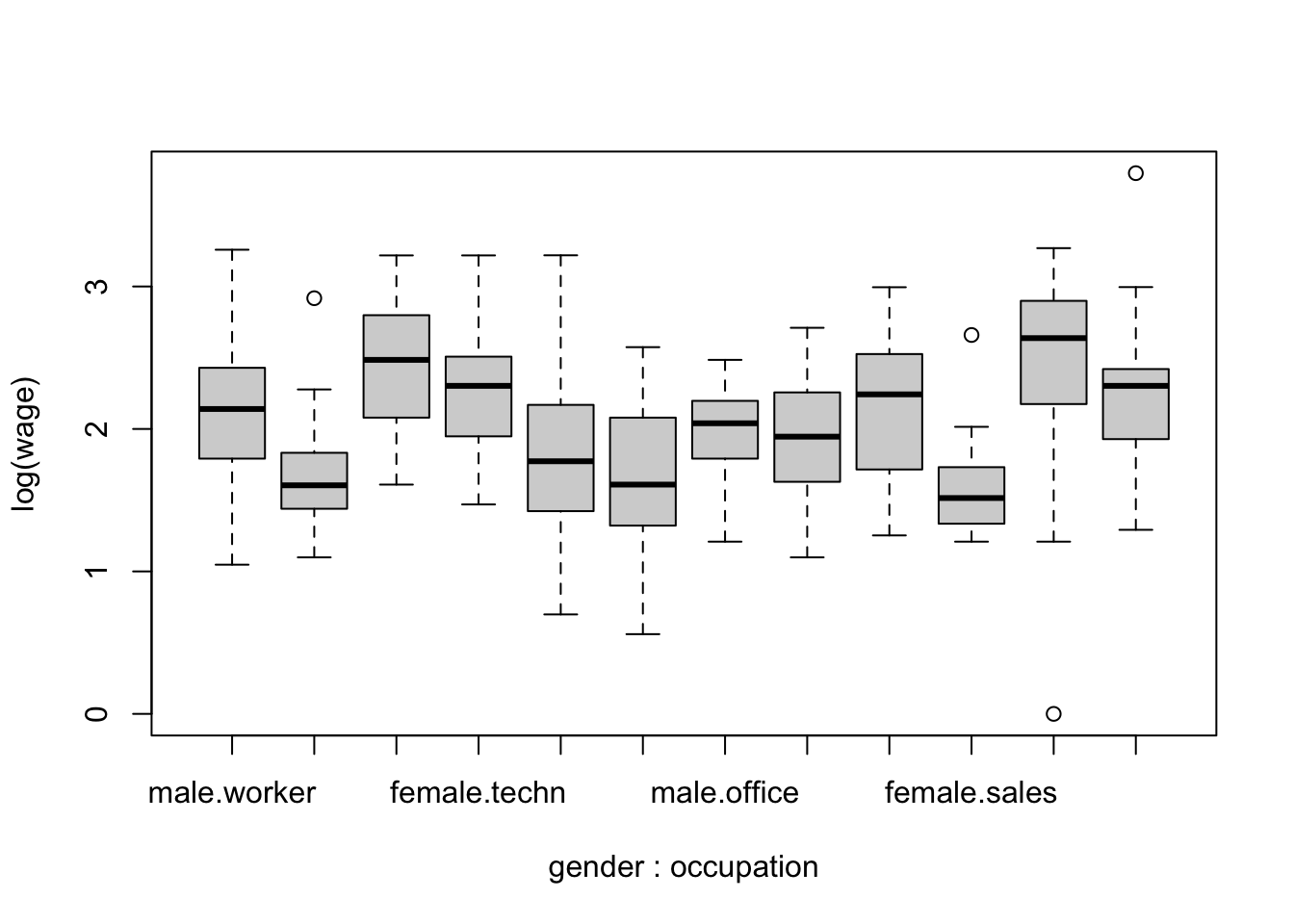
detach(CPS1985) # now detach when work is doneExercises
- Subsetting Data Frames
Create a data frame named student_info with the following columns and data: - student_id (1 to 5) - student_name (‘Alice’, ‘Bob’, ‘Charlie’, ‘David’, ‘Eva’) - student_age (25, 30, 22, 28, 24) - student_grade (‘A’, ‘B’, ‘A’, ‘C’, ‘B’)
Write a command to subset this data frame to include only students older than 24.
- Using Conditional Filters
- Use the subset() function to find all students with a grade of ‘A’.
- Display the names and ages of these students.
- Manipulating Data with dplyr
Load the dplyr package and convert student_info to a tibble.
Use filter() and select() to show the name and age of students who have a grade better than ‘B’.
- Adding and Removing Columns
- Add a new column student_major with values (‘Math’, ‘Science’, ‘Arts’, ‘Math’, ‘Science’) to student_info.
- Then, remove the student_grade column using dplyr.
- Renaming Columns
- Rename the student_name column to name using base R functions and then using dplyr.
- Complex dplyr Operations
- Create a new tibble from student_info that includes all students except those studying ‘Arts’, rename the student_id column to id, and arrange the students by age in descending order.
- Exploratory Data Analysis with dplyr
- Calculate the average age of students grouped by their major using group_by() and summarize() in dplyr.